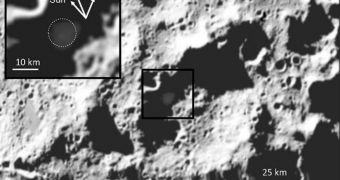Investigators have found in a new study that certain areas of the Moon are wetter than locations on Earth. A polar crater on the natural satellite was found to contain more water ice than the Sahara desert.
The Cabeus crater was the primary target of an investigation that was carried out last year, in October. The Lunar Crater Observation and Sensing Satellite (LCROSS) smashed into the formation, shortly after a spent Centaurus rocket stage was directed into the crater.
The $79 million NASA spacecrafts kicked up a massive dust plume as they struck the lunar regolith, producing temperatures in excess of 1,300 degrees Fahrenheit, and producing the first ever conclusive proof that water ice exists on the Moon.
In six new studies, researchers demonstrate that the Cabeus crater is in fact home to a wide variety of chemicals. These researches represent the continuation of the initial 2009 papers that reported the discovery of water-ice.
Investigators now published the detailed readings that they collected using 22 ground-based and 4 space-based observatories, alongside the Lunar Reconnaissance Orbiter (LRO) spacecraft, then in lunar orbit.
LCROSS mission principal investigator Tony Colaprete says now that studies have finally managed to determine precisely how much water there is on the Moon, Space reports.
According to the new papers, the total mass of the Cabeus crater floor is made of 5.6 percent water ice, which means that the region is twice as wet as the Sahara Desert on Earth.
“That is a surprise. And it has a lot of ramifications in terms of our understanding of water and other volatiles on the Moon,” explains Colaprete, who holds an appointment at the Moffett Field, California-based NASA Ames Research Center.
“I still can't really wrap my brain around it. There are places on the moon that are wetter than parts of Earth – that's kind of neat,” he goes on to say.
But the research teams were also surprised to find a large variety of other chemicals on Cabeus' floor as well, including ammonia, methane, mercury, carbon monoxide, hydrogen, calcium, silver and magnesiums.
What was even more interesting is that, when taken together, these elements accounted for a large proportion of the material on the floor of the lunar crater.
“Where we impacted, up to 20 percent was something other than dirt. t was ices, volatiles, light metals. That was a surprise, that you had so much of this material in there,” Colaprete explains.
“This place looks like it's a treasure chest of elements, of compounds that have been released all over the Moon,” explains Brown University expert Peter Schultz.
“And they've been put in this bucket in the permanent shadows,” adds the expert, who is the author of one of the new papers, published in Science, and the coauthor of another one.

 14 DAY TRIAL //
14 DAY TRIAL //